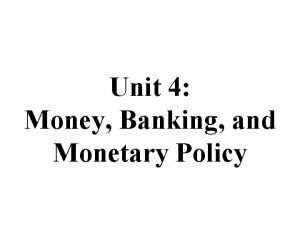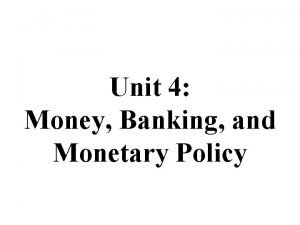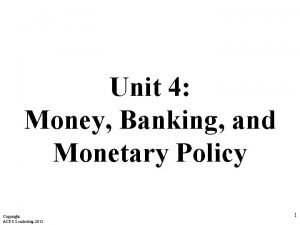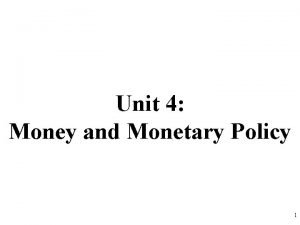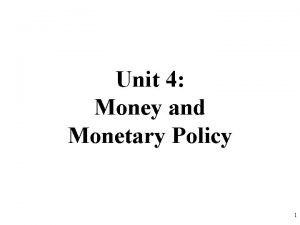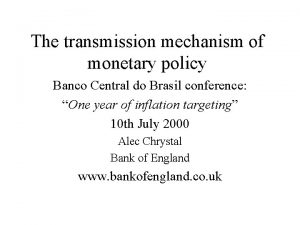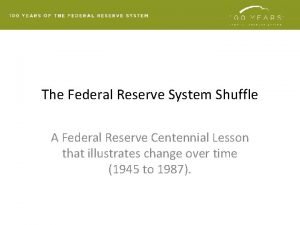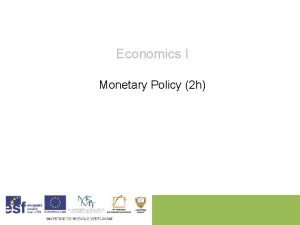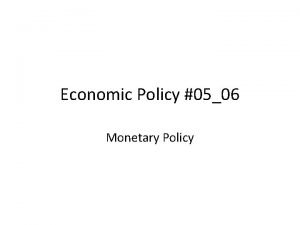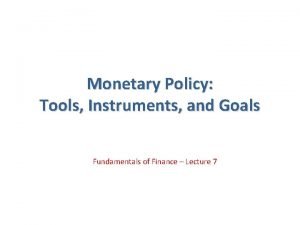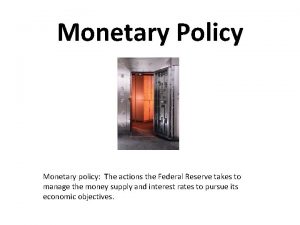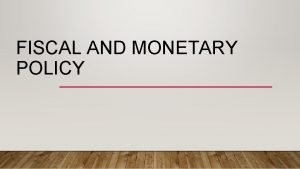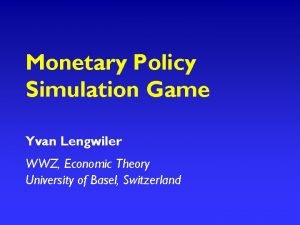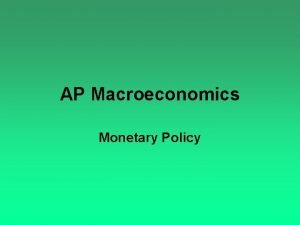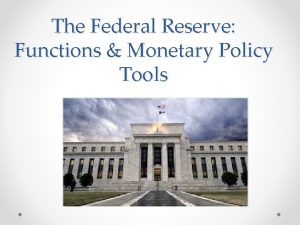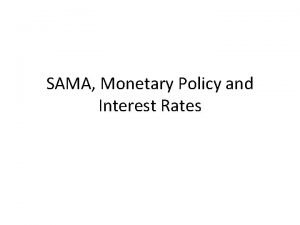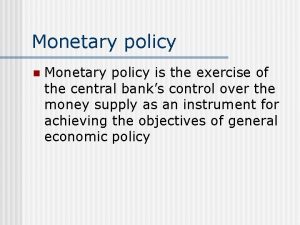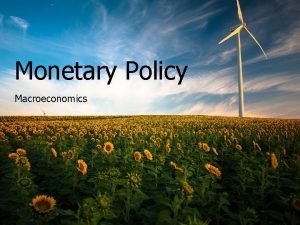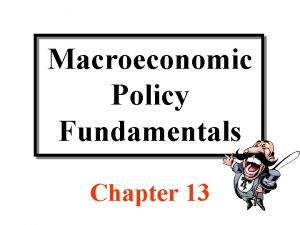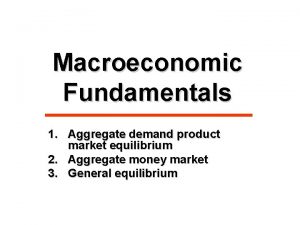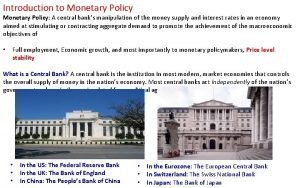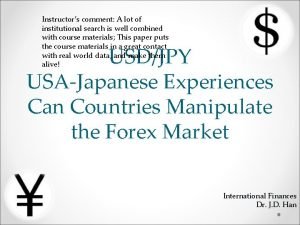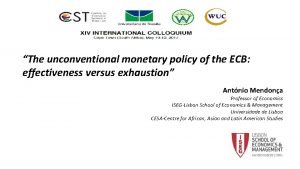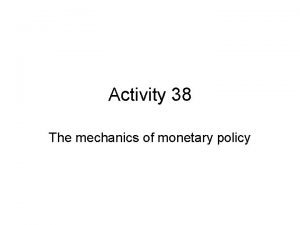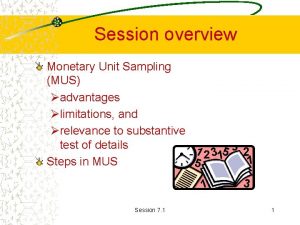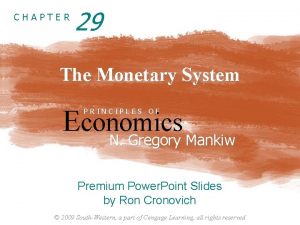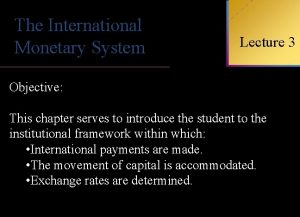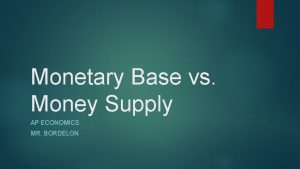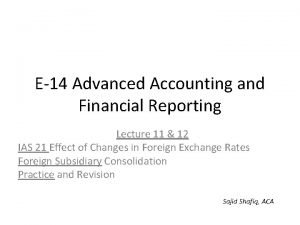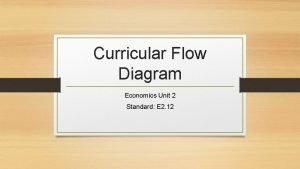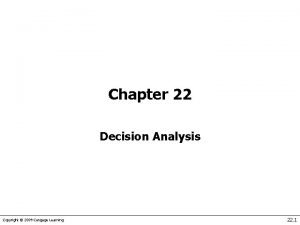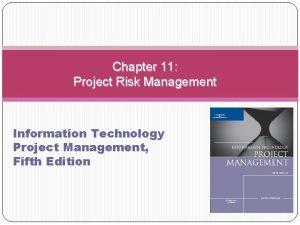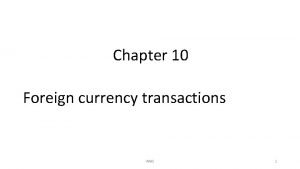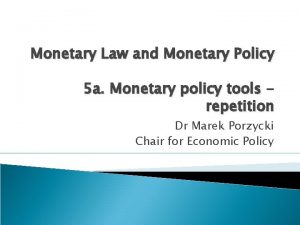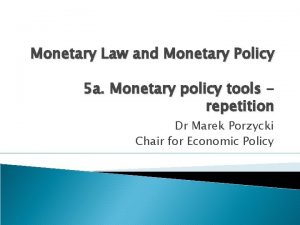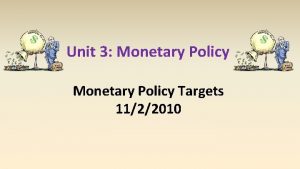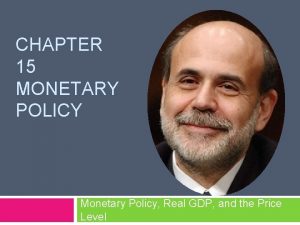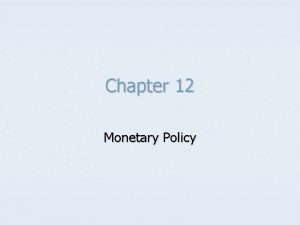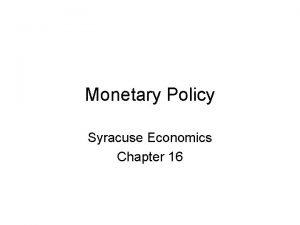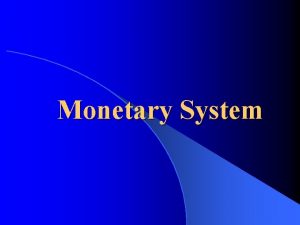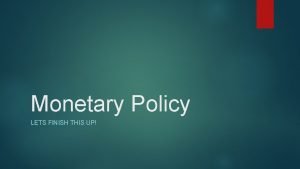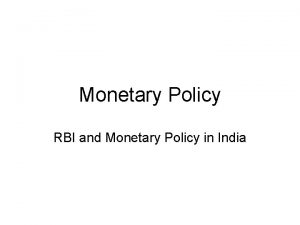Unit 6 Monetary Policy Chapter 15 Monetary Policy













































- Slides: 45


Unit 6: Monetary Policy Chapter 15

Monetary Policy as a weapon? ? ? � Lenin ◦ The best way to destroy a society is to destroy its money. ◦ Why? � Hitler ◦ A great way to undermine the British would be counterfeit their currency and air -drop it over the countryside. ◦ Why?

Monetary Policy Control of Macro Outcomes!

The Money Market � Money: a commodity just like jeans or soda ◦ Governed by the laws of Supply & Demand ◦ Price fluctuates � Quantity of Money ◦ Available supply of money shaped by the Fed � “Price” of Money ◦ Interest Rate: price paid for use of money �High IR =Money is “expensive” �Low IR =Money is “cheap” ◦ Opportunity Cost of Holding Cash=interest forgone

Demand for Money � Demand for Money=quantity of money people are willing and able to hold at alternative interest rates, ceteris paribus � Why hold money? ◦ Transactions demand—everyday use ◦ Precautionary demand—rainy day fund ◦ Speculative demand—hold money for future investment

I demand money! � What determines your demand for money?

IR Money Demand Q$ The Demand Curve for Money A downward sloping curve, showing the inverse relationship between the quantity of money (M 1/M 2) people are willing to hold at any particular rate of interest.

Money Market Equilibrium � Market Equilibrium: intersect of Ms & Md � Equilibrium Rate of Interest: rate where quantity Md= quantity of Ms

Interest Rate (percent per year) Money Market Equilibrium Money supply 9 7 Money demand 0 LO 1 E 1 The amount of money demanded (held) depends on interest rates g 2 g 1 Quantity Of Money (billions of dollars)

Fluctuating Equilibrium � Money supply changed based on Fed ◦ Increase Money Supply Lower Equilibrium Interest Rate ◦ Decrease Money Supply Increase Equlibrium Interest Rate

Changes in MS Changes in IR � Federal Funds Rate: ◦ Most affected by changes in Fed behavior �Spills over to other rates that impact you Interest Rate Type of Loan Rate FFR Interbank reserves 5. 25% Discount Rate Fed reserve loans 6. 25% Prime Rate Bank loans to big corps 8. 25% Mortgage Rate Up to 30 Yr Home Loans 6. 06% Auto Loan Car financing 6. 45% Credit Cards Unpaid credit card balances 15. 09%

Why do Interest Rates Matter? Change IR Change Spending Change AD & Macro Outcomes • Output • Unemployment • Prices

The most powerful man in the world? Apologies to Glenn Hubbard and Congrats (almost) to Janet Yellen What makes monetary policy so powerful?

Today � Monetary Graphish � Practice � Tell Policy in with MP Me a Story…

Loose Monetary Policy Economic Stimulus � 3 Step Process 1. Fed (Directly) increases Money Supply a) Buy bonds b) Lower Discount Rate c) Reduce Reserve Requirement 2. Interest Rates Fall a. Greenspan’s Rule of Thumb: 1/10 point reduction in long-term interest rates equals $10 billion of fiscal stimulus. 3. AD shifts to the right (using the multiplier, of course)

How much of an AD shift? � Add it up…. ◦ I (Investment): new investment in plant and equipment at lower interest rates ◦ C (Consumption): lower rates on mortgages, credit cards means more spending $ & new big purchases ◦ G (Government Spending): gov’t may issue bonds at new low rates

Monetary Stimulus An increase in the money supply lowers the rate of interest A reduction in the rate of interest stimulates investment More investment increases aggregate demand (including multiplier effects) 6 E 2 Demand for money 7 Investme nt demand 6 Price Level 7 E 1 Interest Rate AS AD 1 0 LO 1 g 2 Quantity Of Money 0 I 1 I 2 Rate Of Investment AD 2 Income (Output)

Tight Monetary Policy Economic Stimulus � 3 Step Process 1. Fed (Directly) reduces Money Supply a) Sell bonds b) Raise Discount Rate c) Increase Reserve Requirement 2. Interest Rates Rise 3. AD shifts to the left (using the multiplier, of course)

Walking through the woods… if the Fed raises the reserve requirement Money Market Investment Demand AD/AS or AE/Y

Your turn… � Work with your Screencast group to model the process just detailed. � Each group member should be prepared to present 1 graph in the model (groups of 4 do both AE and AS/AD; groups of 3 pick one) � 10 minutes

Your turn… if the Fed buys bonds Money Market Investment Demand AD/AS or AE/Y

Your turn… if the Fed lowers the discount rate Money Market Investment Demand AE/Y

Your turn… if the Fed sells bonds Money Market Investment Demand AD/AS

Your turn… if the Fed lowers the reserve requirement Money Market Investment Demand AE/Y

Your turn… if the Fed lowers the Federal Funds Rate Money Market Investment Demand AD/AS

Your turn… if the Fed raises the Federal Funds Rate Money Market Investment Demand AE/Y

Your turn… if the Fed raises the discount rate Money Market Investment Demand AD/AS

Interest Rate Applications Loanable Funds Market & Monetizing the Debt

Loanable Funds Market � Quantity of bank reserves available in market at various interest rates ◦ Supply shifts as a result of Fed actions ◦ Demand shifts as a result of fiscal policy and private investment demand � Provides an explanation for crowding out IR S A D 1 Qty Bank Reserves

Monetizing the Debt � Fed’s use of expansionary monetary policy to BUY government bonds ◦ Expands Ms ◦ Reduces interest rates IR S 1 B A C � Supportive policy that limits the effects of crowding out S 2 D 1 Qty Bank Reserves

Tell me a story… � � � Describe a model of the US economy. Use AS/AD and AE models to support your descrption. Explain how the Fed might approach your situation. Select one tool on monetary policy to accomplish the Fed’s goals. Use models of the money market and investment demand as well as your original AS/AD and AE models to show the effects of your policy choice. Fully explain each step.

Limits of Monetary Policy Things don’t always work as we’d like

Short- vs. Long-Term Rates � The success of Fed intervention depends in part on how well changes in long-term interest rates mirror changes in short-term interest rates. LO 2

Reluctant Lenders � Banks themselves must expand the money supply by making new loans. � Banks may be unwilling to make new loans even though the Fed is injecting excess reserves into the banking system. LO 2

Liquidity Trap � The liquidity trap is the portion of the money -demand curve that is horizontal. � People are willing to hold unlimited amounts of money at some (low) interest rate. LO 2

Low Expectations � Gloomy expectations deter people from borrowing and spending in spite of lower interest rates. � Investment demand that is slow to respond to lower interest rates is said to be inelastic. LO 2

Elasticity-the degree to which Qd or Qs changes in response to a change in price (slope) Godiva Chocolate Elastic Gasoline Inelastic

Checking in… � Identify 1 good or service which has a highly elastic demand. Why is it so elastic? What would the curve look like? � Identify 1 good or service which has a highly inelastic demand. Why is it so inelastic? What would the curve look like?

Constraints on Monetary Stimulus Inelastic investment demand can also impede monetary policy Demand for money E 1 E 2 The liquidity trap g 1 g 2 Quantity Of Money LO 2 7 Inelastic demand Interest Rate A liquidity trap can stop interest rates from falling 6 0 Investment demand Rate Of Investment

Time Lags � There is always a time lag between interestrate changes and investment responses. LO 2

Limits on Monetary Restraint � Three factors make it harder for the Fed to restrain aggregate demand: ◦ Expectations. ◦ Time Lags ◦ Global money. LO 2

Expectations � Optimistic consumers and investors may continue borrowing even though interest rates are higher. LO 2

Global Money � U. S. borrowers might tap global sources of money or local non-bank lenders not regulated by the Fed. LO 2

How Effective? � Keynes believed that monetary policy would not be effective at ending a deep recession. � The limitations on monetary restraint are not considered as serious. LO 3
 Unit 4 money banking and monetary policy
Unit 4 money banking and monetary policy Unit 4 money banking and monetary policy
Unit 4 money banking and monetary policy Expansionary monetary policy effects
Expansionary monetary policy effects Unit 4 money and monetary policy
Unit 4 money and monetary policy Unit 4 money and monetary policy
Unit 4 money and monetary policy Unit 4 money and monetary policy
Unit 4 money and monetary policy Transmission mechanism
Transmission mechanism Lesson quiz 16-1 monetary policy
Lesson quiz 16-1 monetary policy Meaning of monetary
Meaning of monetary What is monetary policy
What is monetary policy Types of monetary policy
Types of monetary policy What are the objectives of monetary policy
What are the objectives of monetary policy Objectives of monetary policy
Objectives of monetary policy Expansionary monetary policy aggregate demand
Expansionary monetary policy aggregate demand Policy tools
Policy tools Monetary policy summary
Monetary policy summary Fiscal vs monetary policy
Fiscal vs monetary policy Monetary policy simulation game
Monetary policy simulation game Types of monetary policy
Types of monetary policy Instruments of monetary policy
Instruments of monetary policy Demand pull inflation
Demand pull inflation Moral suasion central bank
Moral suasion central bank Ano ang tight money policy
Ano ang tight money policy Sama exchange rate
Sama exchange rate Instruments of monetary policy
Instruments of monetary policy Expansionary monetary policy flow chart
Expansionary monetary policy flow chart What is monetary policy
What is monetary policy Expansionary monetary policy
Expansionary monetary policy Fractional reserve banking
Fractional reserve banking Features of fiscal policy ppt
Features of fiscal policy ppt Ecb unconventional monetary policy
Ecb unconventional monetary policy Monetary policy baseline
Monetary policy baseline Monetary unit sampling advantages and disadvantages
Monetary unit sampling advantages and disadvantages Chapter 29 the monetary system answers
Chapter 29 the monetary system answers Unit 6 review questions
Unit 6 review questions International monetary system
International monetary system Non-monetary rewards
Non-monetary rewards What is a monetary asset
What is a monetary asset Value driven professional
Value driven professional Monetary base ap macro
Monetary base ap macro Example of non monetary items
Example of non monetary items Example of non monetary items
Example of non monetary items Monetary flow
Monetary flow Expected monetary value
Expected monetary value Expected monetary value
Expected monetary value What is a monetary asset
What is a monetary asset
